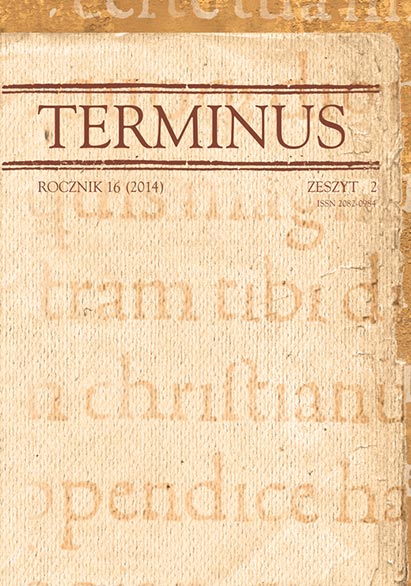Historia i przemiany topoi jako źródło renesansowej reformy dialektyki
The history and changes of topoi as an impulse for the renaissance reform of dialectic
Author(s): Magdalena Ryszka-KurczabSubject(s): Language and Literature Studies, Studies of Literature, Polish Literature
Published by: Wydawnictwo Uniwersytetu Jagiellońskiego
Keywords: history of dialectic; history of rhetoric; topoi; loci; sources of argumentation; dialectical disputation; Aristotle; Cicero; Boethius
Summary/Abstract: The following article presents the most important stages in the history of dialectic in the light of the changes of the topoi theory, from Aristotle’s Topics and Rhetoric, to Cicero’s Topica, Boethius’s tractates (In Ciceronis topica and De topicis differentiis) to the Medieval tradition. The author explains the most important shifts in the nature and function of loci between the 4th c. BC and the 16th c. AD, which allows a better understanding of the reasons of the fierce criticism of dialectic by Renaissance humanists, such as Lorenzo Valla or Rudolf Agricola, as well as the attempts they made to reform it. Aristotle is considered the first creator of topoi that he discussed in the Topics and the second book of the Rhetoric. The right context for understanding the function of loci is a dialectical disputation with its specificity. It seems that for Aristotle topoi were sources of arguments as well as sources of argumentation premises. He acknowledged topos in at least two ways: as a strategy for finding an argument that allows to win a dialectical discussion and as a rule of inference. For the later tradition of loci Cicero’s and Boethius’s commentaries on Topics were significant. Cicero wrote his Topica for a lawyer, Gaius Trebarius Testa, and ignored the context of dialectical disputation that was so important for Aristotle. For Cicero, topos (or locus) is the seat of arguments (sedes argumentorum). Referring to Aristotle’s division of rhetorical modes of persuasion, Cicero divided loci into intrinsic and extrinsic topics. Loci seem to work as pigeon holes, general headings under which one should look for arguments. Following the Stoics, Cicero considered dialectic and rhetoric to be two parts of the general science of logos. He also adopted the Stoics’ conception of dialectic as ars bene disserendi and divided it into two parts: the finding of arguments, i.e. ratio inveniendi (topike), and the judging of them (ratio iudicandi). Boethius, a crucial figure in the history of dialectic as a translator of Aristotle’s Organon, abandoned Cicero’s definition of topos as the seat of arguments and adopted Themistius’ (an early commentator on Aristotle) understanding of locus as a tool for justifying inference. Moreover, he identified topics with propositiones maximae, which are universal and well-known propositions that ‘need no proof (probation), but rather themselves provide proof for things that are in doubt’. Loci are also understood by Boethius to be genera of these universal and undoubted propositions (so called differentiae) and to contain them. According to Boethius, loci are principles of demonstration, they guarantee the validity of an argument. Such approach distinctly subordinates the art of inventing an argument (inventio) to the art of justifying its conclusion (iudicium). Medieval logicians, such as Abelard, Petrus Juliani, Albert the Great, William Sherwood or Lambert of Auxerre, adopted Boethius’ rather than Cicero’s or Aristotle’s approach to the loci. It was not until the Renaissance humanists tried to change the state of the matters, that projects of “new dialectic” were created. Humanists, such as Lorenzo Valla and Rudolf Argicola, aimed to rediscover the real meaning of Aristotle’s Topics and to broaden the way loci were used. Their efforts had a common source: the belief that scholastic dialectic was inadequate to what it was supposed to be in Aristotle’s view.
Journal: TERMINUS
- Issue Year: 16/2014
- Issue No: 2 (31)
- Page Range: 133-150
- Page Count: 18
- Language: Polish

